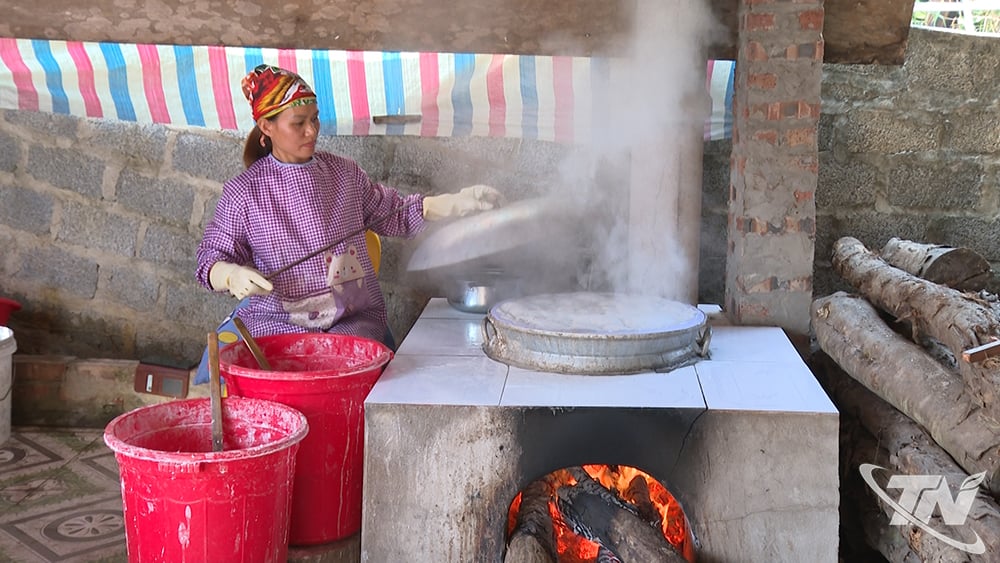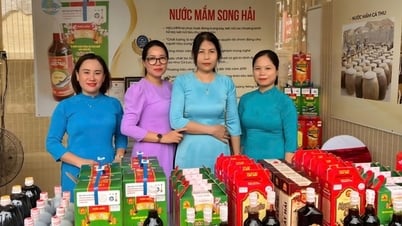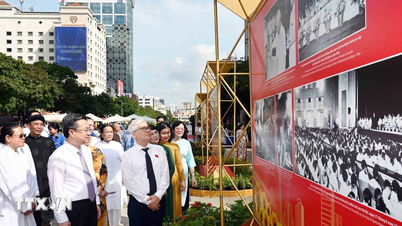 |
| People of Kunming commune make hand-made vermicelli. |
On a clear summer morning, when we arrived at the highland village of Ban Cao, Con Minh commune, we felt like we were touching the cool atmosphere typical of the highlands. When the mist was still hanging lightly on the roof, the fire in the small kitchen of the people of Ban Cao was already blazing red, starting a new day with batches of traditional handmade vermicelli that have been attached through many generations, carrying within them the warmth of memories and aspirations to reach far.
Ms. Luc Thi Bang, who has been making dong vermicelli for more than 30 years: In the past, dong vermicelli was only made during Tet to serve the family. At that time, there were no machines, so people had to use stone mortars to grind each dong riềng root into flour, which was very hard work.
Nowadays, thanks to the grinding machine, it is much easier to get cassava flour, which allows people to produce a lot of cassava flour, aiming for large-scale goods. However, many people still keep the traditional way of making it, using wood stoves and manually making vermicelli to preserve the characteristic flavor.
Not only keeping the profession, Kunming people also started to think about making money from vermicelli. In recent years, when market demand increased, the commune government and local people together built a cooperative model, linked vermicelli-making households, invested in semi-automatic machines to support the stages of filtering flour and pressing vermicelli, helping to increase productivity while still maintaining the handmade quality.
In Ban Cao village, where 54/56 households live in traditional stilt houses, 25 households still make vermicelli by hand-coating method.
Mr. Luc Van Bay, Party Secretary of Ban Cao village, shared: To preserve the traditional vermicelli making profession while still keeping up with modern market trends, villagers determined that it was necessary to invest in machinery and equipment to support production.
Along with that, diversifying product designs, registering trademarks and participating in the OCOP Program are also considered important steps, contributing to enhancing the value and building the Kunming vermicelli brand more and more firmly in the market.
Con Minh commune currently has 3 villages recognized as vermicelli villages: Ban Cao, Tan Lap, Ban Cuon. People here produce vermicelli all year round, with the peak season from September to December. This is the time to prepare goods for the Lunar New Year.
Visitors to the vermicelli village at this time will see people waking up at 3-4am to cut the vermicelli, then light a fire to make the noodles. Each day, a household can make 60-100kg of finished hand-coated vermicelli.
 |
| People in Kunming commune make hand-coated vermicelli. After being hand-coated, the vermicelli is dried in the sun until it becomes dry, then sliced and dried again. |
Hand-fried vermicelli is made from pure arrowroot powder, dried on bamboo racks or mesh drying racks under natural sunlight. Thanks to that, the hand-fried vermicelli has an ivory color, is safe and has a natural sweet aroma of arrowroot powder. In particular, the hand-fried vermicelli retains its length, is chewy and does not break when cooked for a long time. With these characteristics, the price of 1kg of hand-fried vermicelli ranges from 120,000 to 200,000 VND.
The story of the stilt house stove associated with the hand-made vermicelli craft is no longer limited to a single village, but people have grasped the market trend. Currently, the whole province has about 100 hectares of cassava grown organically through programs and projects linking producers and people.
During the planting and care process, farmers do not use pesticides, in order to create clean, safe products, increase the value of agricultural products, and move towards sustainable agriculture .
The journey of Kunming cassava vermicelli, from cassava roots growing on the mountainside to a classified OCOP product, is a vivid demonstration of the ability to “turn what is available into something valuable”, turning tradition into a driving force to promote sustainable and unique rural economic development.
Source: https://baothainguyen.vn/xa-hoi/202508/bep-lua-nha-san-va-cau-chuyen-lam-mien-trang-tay-a1601f3/




























![[Photo] Discover the "wonder" under the sea of Gia Lai](https://vphoto.vietnam.vn/thumb/1200x675/vietnam/resource/IMAGE/2025/8/6/befd4a58bb1245419e86ebe353525f97)


![[Photo] Nghe An: Provincial Road 543D seriously eroded due to floods](https://vphoto.vietnam.vn/thumb/1200x675/vietnam/resource/IMAGE/2025/8/5/5759d3837c26428799f6d929fa274493)































































Comment (0)